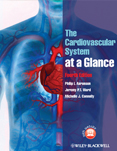- Home
- Cases
- Revision notes
- Your feedback
- Become a reviewer
- 'At a Glance' series
- More student books
- Student Apps
- Join an e-mail list


You are the house officer on the acute medical unit. Overnight an 83-year-old woman has been admitted with chest pain and shortness of breath. On the post-take ward round, the senior house officer on-call that night presents the patient to the consultant. The woman had been feeling unwell and had experienced central chest pain, which was non-radiating. She was short of breath, nauseous, sweaty and clammy. Her past medical history is significant for a coronary artery bypass graft (CABG) in 1989, several non-ST segment elevation myocardial infarctions, atrial fibrillation (AF) and hypertension. Admission bloods were all within normal ranges. Her ECG shows T wave inversion in leads I, aVL and V3–V6 and her chest X-ray shows a raised right hemi-diaphragm and sternotomy wires consistent with her previous CABG. Her blood pressure is 160/90 mmHg. On examination she is comfortable at rest, her pulse is 83 regular, her JVP is not elevated but the character of her carotid pulse is slow-rising. Auscultation of her heart sounds reveals a very quiet second sound and an ejection systolic murmur heard shortly after the first heart sound which is loudest in the second intercostal space in the right upper sternal border and which radiates to both carotids.
1.What is the most likely diagnosis in this woman?
2.Why does she have a soft second heart sound?
3. Which investigation would you like to do next?
4.How would you treat this woman?
See Chapter 53.